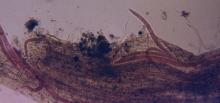Cause The root-lesion nematode Pratylenchus penetrans is a migratory endoparasite where part of the population is in soil and part in the roots at all times. Populations in raspberry generally are low through winter and spring, increase rapidly through the summer, and decline in fall. Densities at or below detectable levels at planting can increase to damaging levels by the sixth-to-eighth year. Other species of this nematode do not cause significant root damage. Most of red raspberry varieties commonly planted in the PNW are good hosts for this nematode.
Symptoms Small, elongated, discolored lesions appear on new roots of infected plants. The fine-feeder roots die as the damage increases. This damage stimulates the formation of many fine roots and a witches' broom appearance. Without feeder roots, the larger diameter roots are unable to take up nutrients and water and often are invaded by secondary fungi. Aboveground symptoms are most often observed on fruiting canes and include reduced cane number and diameter, stunting, and off-color leaves.
Sampling Always include soil and roots in samples sent for nematode analysis if plants are present. Take samples any time if the numbers are interpreted in relation to nematode population dynamics. Before planting raspberry, it is best to sample in late summer so the soil may be fumigated in fall.
If soil with more than 100 P. penetrans/500 cc soil (20/100 g soil) is not treated at spring planting, sample the field annually and treat if populations reach damaging levels. Populations greater than 500 nematodes/500 cc soil (100/100 g soil) at planting will affect stand establishment, first-year growth, and yield.
In established plantings of the late 80's and 90's, densities of 1,000 to 4,000/500 cc (200 to 800/100 g soil) decreased plant growth and treatment was recommended. Based on cropping systems in Washington during 2011 and 2012, postplant nematicide applications were not beneficial. It is unknown if nematicide applications may have longer-term benefits, such as extending plant life or improving plant growth.
Cultural control
- Use certified planting stock.
- Plant in soil free of high populations of root-lesion nematodes.
- Work fumigated and noninfested fields first before moving to nematode-infested fields. Thoroughly clean machinery after leaving infested fields.
Chemical control
- Preplant soil fumigation the fall before spring planting.
- Basamid G. Avoid application when soil is over 90°F. Do not apply within 3 to 4 feet of growing plants. Do not harvest within one year of application. 5-day reentry Restricted-use pesticide.
- Dominus at 10 to 40 gal/A. Apply as a shank injection to an entire field or raised beds when soil temperatures are above 60°F but not greater than 90°F. 5-day reentry.
- Telone II at 27 to 35 gal/A broadcast on mineral soils. Leave the soil undisturbed for at least 7 days after application. A longer interval, such as 2-3 weeks, is required if soils are cold or wet, or the site will be replanted with deep rooted trees, shrubs or vines. Odor indicates fumigant presence; do not plant until odor leaves the soil. Do not treat extremely heavy soils. 5-day reentry. Restricted-use pesticide.
- Vapam HL at 37.5 to 75 gal/A. Immediately roll the soil and follow up with tarps or a light watering. May be used through an irrigation system. 5-day reentry. Restricted-use pesticide.
- Velum Prime at 6.5 to 6.84 fl oz/A can be used after planting using drip, trickle of micro-sprinklers. Can be applied day of harvest. Group 7 fungicide. 12-hr reentry.
- Vydate L at 2 quarts/A can be used after planting on non-bearing plants. Apply 0.25 to 0.5 inches water (or rainfall) to wet the top 2 inches of soil after application. For western Washington only (SLN WA-120005). 48-hr reentry. Restricted-use pesticide.
Biological control
- MeloCon WG (Paecilomyces lilacinus strain 251) at 2 to 4 lb/A plus a soil wetting agent can be applied to established plants, although it might be better used when applied to plants just before planting. Stable for only days at room temperature, weeks in the refrigerator or for a year if frozen. Unknown efficacy in the PNW. 4-hr reentry. O
Note: Some registered products offer only suppression of this disease and thus are not recommended for use. These products include Majestene.
Reference Zasada, I.A., Weiland, J.E., Han, Z., Walters, T.W., and Moore, P. 2015. Impact of Pratylenchus penetrans on establishment of red raspberry. Plant Disease 99:939-946


